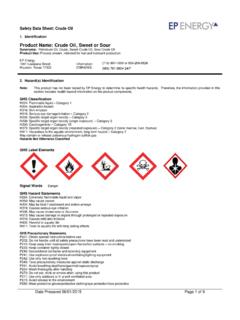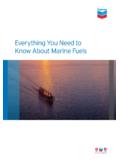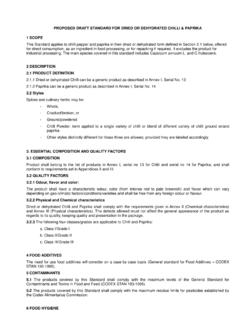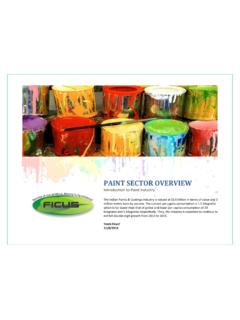Transcription of Safety Data Sheet - Whiting Petroleum Corporation
1 product name : Produced Water ( sweet ) Page 1 of 6 Safety data Sheet 1. Identification product name : Produced Water ( sweet ) Synonyms: Produced Brine, Salt Water, Formation Water Chemical Family: Water Manufacturers name : Whiting Oil and Gas Corporation Address: 1700 Broadway, Suite 2300 Denver, Colorado 80290 product Use: Bi- product of crude oil production. Phone Number for Information: (303) 837-1661 Emergency Phone Number: (800) 424-9300 (Chemtrec) Produced water is natural substance which contains water and minerals, primarily salt (NaCl). Substances in produced water can kill vegetation and should not be ingested, but they are not generally considered hazardous. Produced water can become hazardous if it contains hydrocarbons (crude oil, condensate or natural gas).
2 Please refer to SDS's on these substances for more complete information 2. Hazard Identification Produced water may contain crude oil or condensate and may accumulate a layer of oil on its surface; the oil is flammable and may contain benzene which is a carcinogen. Along with oil or condensate, natural gas can get entrained or become dissolved in produced water. This gas can accumulate in tanks or vessels and become a fire hazard. Produced water may also contain Naturally Occurring Radioactive Material (NORM), but the amount contained in the water itself should be well below any hazardous concentrations. NORM however, may be present at harmful concentrations in scales which can be deposited from produced water in piping, tanks and vessels.
3 Certain state regulations may require a NORM survey be conducted before entering or working on any tanks, vessels, or lines with the potential to contain NORM contaminated scale or sediment. If NORM is present, contact Whiting 's Safety Department for guidance. WARNING! MAY CONTAIN FLAMMABLE LIQUIDS PRODUCES SKIN IRRITATION UPON PROLONGED OR REPEATED CONTACT. LONG-TERM EXPOSURE TO COMPONENTS OF THIS MATERIAL HAS CAUSED SYSTEMIC TOXICITY AND CANCER IN LABORATORY ANIMALS. NO SMOKING! WEAR PROTECTIVE GLOVES, CLOTHING AND EYE WEAR WHEN HANDLING. AVOID RELEASE INTO THE ENVIRONMENT. product name : Produced Water ( sweet ) Page 2 of 6 Globally Harmonized System (GHS) Information Physical Hazards Classification none Health Hazards Classification Skin Corrosion/irritation, Category 2 Serious eye damage/eye irritation, Category 2a Carcinogenicity, Category 1B Environmental Hazards Classification none GHS Label Information Symbols: Signal Word: None Hazard Statements: Precautionary Statements.
4 Physical Hazards none Health Hazards May cause cancer Causes eye irritation Causes mild skin irritation Environmental Hazards none Prevention Wear protective gloves/protective clothing/eye protection/face protection Wash hands thoroughly after handling Do not eat, drink or smoke when using this product Avoid release to the environment Response IF ON SKIN (or hair): Remove all contaminated clothing. Rinse skin with water/shower If exposed or concerned: Get medical attention or advice IF IN EYES: Rinse cautiously with water for several minutes. Remove contact lenses if present and easy to do. Continue rinsing. If exposed or concerned: Get medical attention or advice Storage none Disposal Dispose of contents/container in accordance with local/regional/national/international regulations 3.
5 Composition/Information on Ingredients COMPOSITION CAS NUMBER PERCENT Water 7732-18-5 80-100 Sodium Chloride 7647-14-5 0-20 Hydrogen Sulfide 7783-06-4 < Benzene 71-43-2 <1 Crude Oil 8002-05-9 <1 product name : Produced Water ( sweet ) Page 3 of 6 4. First Aid Measures Eye Contact Immediately flush eyes, while holding eyelids open, with large amounts of clean, low-pressure tepid water for at least 15 minutes. If symptoms, irritation or injury persists, worsen or develop, seek medical attention. Skin Contact Remove contaminated clothing/shoes, wipe excess from skin. Immediately flush skin with water for 15 minutes then wash with soap and water. If illness or adverse symptoms develop or irritation persists, seek medial attention. Discard contaminated leather goods.
6 Inhalation Immediately remove from contaminated area to fresh air. If symptoms persist, seek medical attention. Ingestion Rinse mouth with water. Drink 1-2 glasses of water or milk. Do not induce vomiting unless directed by medical personnel. 5. Fire-Fighting Measures This material is nonflammable. It may contain crude oil, condensate, or natural gas, all of which are flammable. Extinguishing Media: Foam, dry chemical, CO2 Special Fire Fighting Procedures and Precautions: None Unusual Fire Explosion Hazards: None NFPA Ratings Health 1 Flammability 1 Reactivity 0 Other 0 Key: Least-0; Slight-1; Moderate-2; High-3; Extreme-4 6. Accidental Release Measures This material should not present a serious problem under anticipated conditions.
7 Contain spill and cleanup as soon as possible. Wastes can be disposed of by landfill, underground injection, or by permitted discharges. Federal, state, and local regulations should be followed in disposing of this material. 7. Handling and Storage Comply with all regulatory requirements. Store in suitable tanks or closed, labeled containers in a cool, well-ventilated area. product name : Produced Water ( sweet ) Page 4 of 6 Keep liquid and vapor away from heat, sparks and flame. Surfaces that are sufficiently hot may even ignite liquid product in the absence of sparks or flame. Extinguish pilot lights, cigarettes and turn off other sources of ignition prior to use and until all vapors are gone. Containers, even those that have been emptied, can contain explosive vapors.
8 Do not cut, drill, grind, weld or perform similar operations on or near containers. Static electricity may accumulate and create a fire hazard. Ground fixed equipment. Bond and ground transfer containers and equipment. Remove scales with elevated NORM before grinding or cutting. Wash hands with soap and water before eating, drinking, smoking or using toilet facilities. Launder contaminated clothing before reuse. Dispose of leather articles including shoes which cannot be decontaminated. 8. Exposure Controls/Personal Protection Occupational Exposure Limits COMPONENT OSHA PEL ACGIH TLV TWA Water Not available Not available Sodium Chloride Not available Not available Benzene 1 ppm**/STEL 5 ppm ppm Crude Oil 400 ppm ** Not available Notes: ** OSHA s action level is ppm (29 CFR ) ** Listed PEL was vacated in 1993 Engineering Controls Maintain air concentrations below flammable limits and occupational exposure standards for chemical components by using ventilation and other engineering controls.
9 Personal Protective Equipment Eye/Face Protection Eye protection ( splash goggles or face shield) should be worn whenever there is a likelihood of splashing or spraying liquid. Contact lenses should not be worn. Suitable eye wash water should be available. Skin Protection Avoid skin contact. Wear protective clothing and gloves. Neoprene or nitrile gloves generally offer good protection. Wash thoroughly after handling. Respiratory Protection If ventilation is inadequate, use NIOSH certified respirator which will protect against organic vapor/mist. If operating conditions cause high vapor concentration or TLV is exceeded; use supplied-air respirator approved by NIOSH. product name : Produced Water ( sweet ) Page 5 of 6 9. Physical and Chemical Properties Appearance and Odor: Colorless to cloudy may contain small amounts of solids or oil.
10 May be odorless or smell like hydrocarbons. pH: approximately 7 Melting Point/freezing point: <32 F Boiling Point: 212-220 F Flash Point and Method: not applicable Evaporation Rate: Slower (N-Butyl Acetate =1) Flammable Limits: not applicable Vapor Pressure: mm Hg Specific Gravity: to (H2O= ) Vapor Density for water vapor (Air=1) Solubility: 100% (in water) Partition coefficient (n-octanol/water): not applicable Auto ignition temperature not applicable Decomposition temperature not available Viscosity to cp at 68 F 10. Stability and Reactivity Stability: Stable Hazardous polymerization: Will not occur Conditions and Materials to Avoid: Avoid heat, sparks, open flame, strong oxidizers, acids, bases Hazardous Decomposition Products: Excessive heating releases harmful gases and vapors, entrained in the water.







